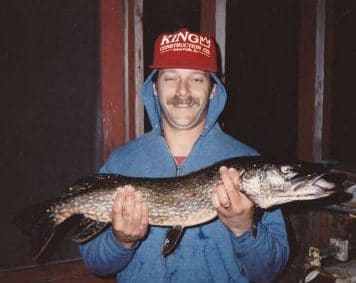
If you have been reading our work at amazingoutdooradventures.com for a while now, you probably realize we are huge fans of northern pike fishing. I think both my brother and I would agree some of our favorite fishing memories were catching large northern, and gaining epic fishing stories by having our lines snapped & lures lost by giant pike as well.
If you haven’t been pike fishing before, it is something you need to try. Pikes are an aggressive fish that strike hard & fight hard – making it a very enjoyable fishing experience.
If you have been pike fishing before and are looking for some tips or just basic information on northern pike fishing – you have come to the right place.
Our goal was to create a really good guide on northern pike fishing – with basic information about the fish, tips on when & where to pike fish, and tips on northern pike fishing gear.
With a fun combination of personal stories and the above-mentioned tips, I hope you enjoy our Ultimate Guide to Northern Pike Fishing!
Table of Contents
Basic Pike Information
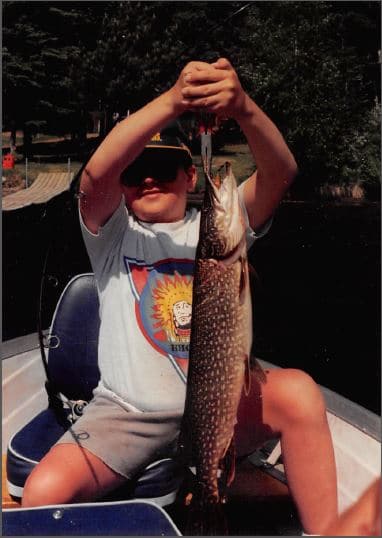
Northern pike, or just pike, are very common around the world and are fun to fish due to their aggressive nature and large size. The average pike is normally between 16 – 22 inches, which is a fun catch!
For a quick history lesson, the northern pike gets its “pike” name because it resembles the pike weapon (that long pole with a sharp point or little ax-looking thing at the end) that you see in movies and video games.
The second quick history lesson, according to Wikipedia (the best place for information ever, right?) other unofficial names for pike over the years include lakes pike, snot rocket, slough shark, slough snake, slimmer, snake, gator, jackfish, hammer handle, and some various other incarnations like northern. I’m probably going to start calling them hammer handles now.
Hammer handles (see what I did there) have a very distinct look that makes them very easy to distinguish from other fish. Pike has a very long body with a pointed head. They are most often an olive-green color, with a yellow or white shading along the belly. Younger pike will have yellow stripes that run along their green body; the stripes will turn into spots and the body will turn from green to olive-green as they mature. Pike looks very similar to their relative the muskie.
Northern pike in Europe tends to be bigger than the northern pike in North America. Pikes in Europe or North America are going to be ambush predators – meaning they are going to wait in cover for long periods before striking fish or other prey. This is why lures that make noises, are shiny, and replicate injured fish are very successful when fishing for pike.
For those interested in animal science, the northern pike is a very aggressive fish, and this has even led to cannibalism with young pike occurring in certain situations. When food is scarce or overcrowding is occurring – northern pike will fight for survival and even attack each other. Pike that is in one of these cannibalism situations do not discriminate towards siblings – they will attack whatever fish they need to survive. Larger pike is also territorial, which is why these fights can occur when overcrowding occurs.
Due to how aggressive pike is, there are some places where laws have been enacted to prevent pike from spreading. For example, if you read the California Sport Fishing Regulations guide – “No northern pike, dead or alive, maybe released into any water at any time. All northern pike taken shall be killed immediately by removing the head.” That is a pretty cool exert from the California regulations guide – and if you keep reading the article, you will see why California isn’t on the list of record northern pike catches.
I will also tell you that I find northern pike to taste great, and it freezes very well – as long as you know who to fillet it properly. The “Y-bones” can be pretty tricky to remove.
Where to find Pike!
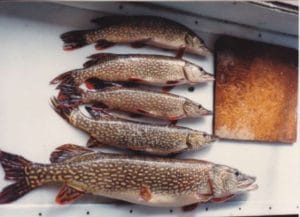
Northern Pike can be in found all over the world in Russia, Europe, Canada, and much of the United States. The biggest northern pike is going to be in Europe, with the world-record northern being just slightly over 55 pounds (caught on Lake Grefeeren, Germany).
That doesn’t mean big pike can’t be caught in the United States and Canada – there have been 40 – 45-pound pike caught in both the US and Canada!
Most people would say the best states for pike fishing are normally, Minnesota, Wisconsin, North Dakota, South Dakota, Michigan, Vermont, New York, Colorado, and Alaska – but there are some nice fish in other states as well! Pike can be found in Alberta, Saskatchewan, Manitoba, Ontario, and Quebec in Canada.
When planning that big pike fishing trip, do a little research on the state you want to fish in, and you should be able to find some great information on different pike lakes and places to fish. State DNR sites are a great resource to see where to fish, and where fish are biting!
I think this is some fun information, so check out this chart of the record pike caught in each state!
State Record Northern Pike
| State | Size | Year Caught |
|---|---|---|
| Alaska | 38 lbs | 1991 |
| Arizona | 32 lbs 5.6 oz | 2004 |
| Arkansas | 16 lbs 1 oz | 1973 |
| Colorado | 30 lbs 11 oz | 2006 |
| Connecticut | 29 lbs 11 oz | 1980 |
| Georgia | 18 lbs 2 oz | 1982 |
| Idaho | 40 lbs 2 oz | 2010 |
| Illinois | 26 lbs 15 oz | 1989 |
| Indiana | 30 lbs 2 oz | 1992 |
| Iowa | 25 lbs 5 oz | 1977 |
| Kansas | 24 lbs 12 oz | 1971 |
| Kentucky | 9 lbs 8 oz | 1981 |
| Maine | 31 lbs 2 oz | 1998 |
| Maryland | 24 lbs 12 oz | 1999 |
| Massachusetts | 35 lbs 0 oz | 1988 |
| Michigan | 39 lbs oz | 1961 |
| Minnesota | 45 lbs 12 oz | 2002 |
| Missouri | 18 lbs 9 oz | 1975 |
| Montana | 37 lbs 8 oz | 1972 |
| Nebraska | 30 lbs 1 oz | 1997 |
| Nevada | 27 lbs 0 oz | 1978 |
| New Hampshire | 23 lbs 1.6 oz | 1996 |
| New jersey | 30 lbs 8.5 oz | 2009 |
| New Mexico | 36 lbs 0 oz | 1974 |
| New York | 46 lbs 2 oz | 1940 |
| North Carolina | 11 lbs 13 oz | 1978 |
| North Dakota | 37 lbs 8 oz | 1968 |
| Ohio | 22 lbs 6.8 oz | 1988 |
| Oklahoma | 36 lbs 8 oz | 1976 |
| Pennsylvania | 35 lbs | 2003 |
| Rhode Island | 35 lbs | 1987 |
| South Dakota | 36 lbs 3 oz | 1993 |
| Tennessee | 24 lbs 8 oz | 1995 |
| Texas | 18 lbs 4 oz | 1981 |
| Utah | 25 lbs 0 oz | 2002 |
| Vermont | 30 lbs 8 oz | 1977 |
| Virginia | 31 lbs 4 oz | 1994 |
| Washington | 34 lbs 6 oz | 2004 |
| West Virginia | 22 lbs 1 oz | 1989 |
| Wisconsin | 38 lbs 0 oz | 1952 |
| Wyoming | 27 lbs 4 oz | 2005 |
When is the best time of the year to fish for Northern Pike?
The best time to fish for large northern pike is a few weeks after the ice is out and the water starts to warm up a little bit. I think most everyone would agree May is the best month to target large/trophy pike in the upper United States and southern Canada. It is just after the spawn, so northern pike is going to be eating a whole bunch of baitfish in shallow water (plus they are extra aggressive and haven’t seen a lure in months!).
Summer pike fishing can also be very successful in the artic watershed and other cooler water locations across North America. Pike are just more active in cooler water – many fishing experts would say around that 65°F water temp. or cooler – so warm water & hot summer days can slow down your pike fishing success.
This is also why a lot of anglers will travel way up north to catch large pike. The longer the water stays at 65°F or colder, the longer the pike is going to stay active. Some of those northern lakes don’t get much warmer than that 65° temperature, meaning you can fish for large pike a lot longer than you can in warmer Midwest United States lakes.
Generally speaking, smaller to medium sized pike can handle the heat a little better and are going to be more active in summer months than those large trophy pike that we all dream of catching. Still, all pike are really fun to catch and I’ve had a ton of fun catching large numbers of pike in June & July.
When do Northern Pike Spawn?
Northern pike is going to spawn after the ice is gone. Right after the ice is gone and the water temperature reaches about 40°F. Normally eggs are going to be laid in underwater vegetation that is located in shallow water.
So, for large northern pike in the northern area of North America – spawning is usually going to be in April. Large pike can be caught during that spawn and right before spawning takes place, but the best time is right after that spawn, normally in May.
Make sure to check all local fishing regulations to see if there are any regulations about pike fishing during or before the spawn – and seeing what limits are set for pike fishing season.
Habitat to fish for Pike

There are some different places and types of structures you are going to want to fish when looking for a pike.
During the pre-spawn and early spawn, you are going to want to fish bays. Fish the part of the bay that faces the sun first because they are going to warm up faster, and draw fish in first during that warm-up stage.
You are also going to want all those secondary coves that warm-up before the main bay does. Pike will also spawn in these shallow areas and they can be great places to fish.
Pike are big predators, so fish spots where large groups of baitfish gather. You want to look for good shoreline structures, downed trees, reed beds, large grassy areas – basically those places that provide pike with cover and food.
When the water gets warmer, the large pike is going to leave to find deeper; cooler water. Deeper weed lines and deeper water with a good structure are excellent places to jig or troll for pike.
Personally, I love fishing shoreline structures, reed beds, and shallow waters that provide excellent cover spots for pike. The good news is, if they get attracted to your lure, they are going to strike it and you are going to feel it!
Pike Fishing Lure Tips
 There is always going to be an endless debate about what northern pike fishing lure is the best – and people need to realize there are many different fishing lures that are excellent for pike fishing.
There is always going to be an endless debate about what northern pike fishing lure is the best – and people need to realize there are many different fishing lures that are excellent for pike fishing.
Personally, I am going to steer towards crankbaits, jerk baits, and topwater lures because I am the most comfortable fishing with them. Others are going to steer towards spoons, jigs, and soft plastics. All of them have caught some big northern – so make sure you pick a lure that you are comfortable fishing!
You may have a lot of different lure choices to pick from, but most of those lures are going to share some common characteristics.
- Size matters – I know people might be tired of hearing this, but when you are chasing large northern, big lures are a good idea. Northern pike is a predator, and large lures will give them a large area to strike. Have I caught smaller northern on smaller lures? Sure, but if I’m pike fishing, I want to give myself the best opportunity to catch large fish!
- Shiny is good – I really like reflective, shiny lures that are easy to see in the water. Spinner blades & crankbaits that glimmer and shine help give pike that extra reason to strike your lure. That shiny lure means more hits for you!
- Obnoxious is good – When I say obnoxious is good, I mean you want a lure that going to get attention. Rattles in either a jig or spoon, or rattles in a crankbait (I love rattle traps!) are going to help get that northern’s attention. Topwater lures that make waves and ripples can be extremely effective as well!
- Cater to that predatory instinct – Pike are predators, so let’s use lures that get them to attack. This is why I love rattle traps, Rapalas, Heddon Rattlin’ Spook baits, and Live Target jerk baits – because they mimic injured or fleeing fish – which gets pike to strike!
- Use proper techniques – This seems simple, but make sure you are using the proper fishing technique to go along with your lure. Some need a “walk the dog” method, others can be cast and trolled, while jigs have their own unique technique. If you don’t know what technique to use, do a little research online, YouTube probably has a video to show you how to use your bait properly.
These tips should get you started on picking the right type of lures for pike fishing. For specific lure recommendations, check out this review on the Best Northern Pike Fishing Lures – which has links to buy, in-depth analysis, and personal stories about why these lures are great for pike fishing! For my top 3 choices – check out the links below.
Pike Fishing Rod Tips
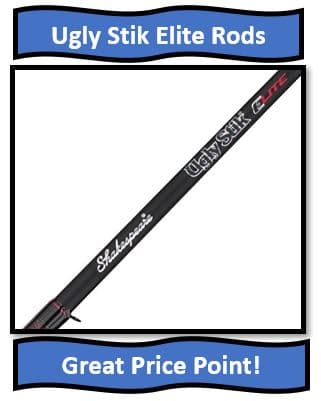 No matter what type of fishing you are doing, I always consider the fishing rod you pick to be the foundation to your success. You need a fishing rod that has the strength, sensitivity, and ability to handle the fishing line & lures needed to catch your desired fish species.
No matter what type of fishing you are doing, I always consider the fishing rod you pick to be the foundation to your success. You need a fishing rod that has the strength, sensitivity, and ability to handle the fishing line & lures needed to catch your desired fish species.
For northern pike fishing, there are a few things that I am looking for from my rod in terms of size, strength, and action. Some people prefer slight variations from my main recommendations, but what I’m concerned with is having a rod that can handle the necessary pike tackle – plus have enough strength to handle the hard-hitting power of a large northern pike.
- Tip 1 size – I prefer a 6 1/2 or 7-foot rod. The rod needs to be strong and be long enough to handle trolling and the action of heavier lures.
- Tip 2 strength – I prefer a medium-heavy rod, but I will use a heavy power/strength rod when I’m hunting for the big ones.
A medium heavy rod should handle fishing lures as large as 1 oz. and line in the 10 – 20-pound test line area. That is the line size and lure size that I’m normally going to be pike fishing with.
A heavy rod can use larger lures and larger test lines, which is why I like that style of the rod when going after the big ones!
The other issue you are always going to hear debated is one piece or two? For me the answer is one, I feel those rods have more backbone for setting the hook and have a little more sensitivity in controlling your lure.
However, a one-piece rod is certainly more difficult to travel with when compared to a two-piece rod. I have caught many northern on two-piece rods, so this isn’t a deal-breaker for me – I just prefer one-piece rods!
For a really in-depth review of different pike fishing rods, please read our article on the best pike fishing rods linked here!
For a quick recommendation, here are my three favorite pike fishing rods in the 6 1/2-foot size, 1 piece, medium-heavy action category I prefer!
The Best Northern Pike Fishing Line Tips
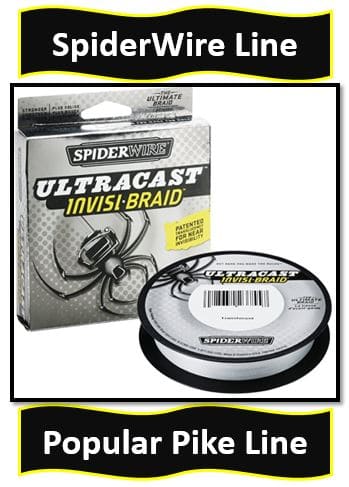 There is always a lot of debate on what type of fishing line to use when pike fishing. What I’m going to do is give you my tips & recommendations that have worked really well for me.
There is always a lot of debate on what type of fishing line to use when pike fishing. What I’m going to do is give you my tips & recommendations that have worked really well for me.
Tip One – do not use a regular monofilament fishing line that is attached directly to your lure. Like we mentioned above, a northern’s teeth are just too sharp, and they are going to rip that line apart.
However, it is okay to use a regular monofilament line when it is attached to a wire leader – with that wire leader normally being 12 inches long or longer. The wire leader will protect the line from being cut by the fish’s teeth.
The benefit of using a monofilament line for pike fishing is they are good when casting. The line has great give to it, and the cast-ability (that probably isn’t a word) of it is better than a lot of braided lines.
For casting lures like Rapalas or Spoons, you are going to want your monofilament line to be a 10+ pound test line – I normally use a 12-16-pound test line. This should be strong enough to handle most large pike and still give you a line that works well.
When you are trolling, you can still use the monofilament line, but you are going to want to be in that 18 – 20-pound test line, and still make sure you use your wire leaders!
Tip Two – There are a lot of anglers that will use braided line because it is much more difficult to cut than monofilament line. I have had success using braided fishing lines when pike fishing – even without a wire leader on.
The upside to the braided line is the extra strength it has. The downside is it doesn’t cast nearly as well as monofilament, and can be a little more difficult to handle.
If you aren’t going to use a wire leader, you need to have the extra strength of a braided line to handle those pike teeth.
Spiderwire is a very popular type of braided fishing line, but there are many good options to choose from.
Tip Three – Unlike a lot of other fish, I worry a lot less about being able to see this fishing line in the water than how strong it is. Pike don’t seem to care if the line is visible or hidden in the water – they just want to strike those lures.
Good Fishing Line Options include:
Wire Leaders
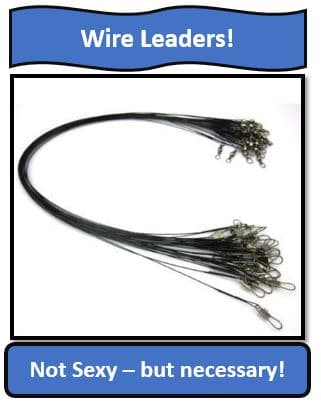 Almost anytime that you are northern pike fishing, you are going to want to have a wire leader. Pike have those incredibly sharp teeth that will tear thru regular monofilament line – making wire leaders a necessity – especially for big fish.
Almost anytime that you are northern pike fishing, you are going to want to have a wire leader. Pike have those incredibly sharp teeth that will tear thru regular monofilament line – making wire leaders a necessity – especially for big fish.
If you are trolling with large crankbaits, or if you are doing a fast cast and retrieve technique with large lures – you can probably get away without using a wire leader.
If you are using a spoon, spinner, jigging, or using pretty much any other type of fishing technique- the wire leader is going to be necessary or you are going to be saying goodbye to your tackle.
A downside to using wire leaders is they can negatively influence the motion and action of your lure. The plus side is they keep large northern pike from cutting your line all the time.
When you are buying wire leaders, I recommend buying one in the 12-inch length range, that is in the 20 to 30-pound strength range, and I prefer a black or silver-like color.
For a complete list of wire leaders, check out our full article on them listed here – Wire Leaders for Northern Pike Fishing.
This is not the sexiest piece of equipment- but it is necessary for large northern fishing success!
Pair of Needle Nose Pliers & Jaw Spreader
These may seem like a no-brainer, but if you are going to be northern pike fishing, you are going to want a good pair of needle nose pliers.
For safety reasons, you don’t want to be sticking your hands in the mouth of a big pike. The teeth are sharp, you can get cut, and pike will try to bite anything.
When you remove your lure with your set of pliers, make sure you have a firm grip on the fish – most of the time I will control the pike with a firm grip on the back of the head.
For real large northern you may need a jaw spreader so you can effectively and safely get to the fish. Having a jaw spreader in your tackle box is a great idea.
Do yourself a favor and make sure you pack a good pair of pliers – if you need a list of good pliers to pick from, check out this review we did on fishing pliers!
Northern Pike Fishing Nets
 One piece of equipment that is often overlooked is a good fishing net. This is particularly important when you are fishing for large fish like northern pike. A small net just isn’t going to work.
One piece of equipment that is often overlooked is a good fishing net. This is particularly important when you are fishing for large fish like northern pike. A small net just isn’t going to work.
When you are buying a northern pike fishing net there are a few important factors you need to look for. The size must be large. You need a deep net, usually around 30 inches deep at a minimum, and you also want to make sure the hoop size is large as well.
You also want to make sure the mesh holes of the net are larger in size. The large holes make the net easier to maneuver in the water, which is important when trying to capture a large pike. It also reduces water resistance making it easier to lift the fish out of the water – also very important. I like the mesh holes to be at least an inch in size.
I prefer a net that has an aluminum or similar material handle – because it will be both durable and lightweight. We sometimes forget how hard it is to scoop up a 10 or 15-pound fish, so you need that extra strong net.
Also, make sure you buy a net that has a long enough handle. Other features like storability and cost are also important to examine when purchasing a new net.
For a full breakdown of northern pike fishing nets – please click on that linked article.
Really Good Nets Include:
Some Other Quick Northern Pike Fishing Tips
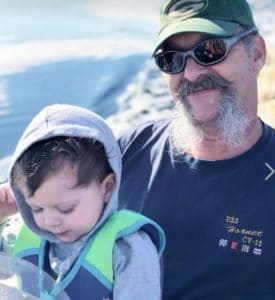
1.) Regular monofilament line isn’t going to do you much good. Like we mentioned above you are going to want a wire leader most of the time, and a strong test line. You aren’t going to want to fish for pike with 6 or 8-pound monofilament line – unless you are a fan of losing lures.
2.) Always use your net and pliers. Don’t stick your hand in a pike’s mouth, those teeth are sharp and can cause a lot of pain – so use your pliers! This also means you shouldn’t stick your arm in the water to pull out a fish. There is a reason why we list nets and pliers under the important northern pike fishing equipment section!
3.) Experiment. Have some fun and throw out many different lures and color combinations. See which ones get you hit, so you can add to the endless debate of what is the best northern pike fishing lure.
4.) Do a little research. Check out the lake or river you are going to be fishing on. DNR sites often provide some great information on where pike or biting. Do a little online research on that lake, and if you can ask some locals! Local fish stories are the best.
Personal Pike Fishing Stories
The best part of fishing is the stories you get to tell and the memories you get to make. So what good is an Ultimate Pike Fishing Guide without some firsthand stories & memories!
Shane’s favorite pike fishing memory

Honestly, there are a lot of times out on the water fishing for northern that I remember fondly, and as much as I loved the time Jon, me, Dad, and Uncle Ken (I think?) took advantage of a flood year to get into a small pond or “lake” that was usually cut off by trees and ground from the rest of the lake (and were a northern pike too small to catch hit every cast like a fearless 20 lb monster), I have to go with my memories of trolling crankbaits on the backside of Boy Scout Island.
This was during one of our week-long family fishing trips to Lac De Millie Lacs up to Maki Bay, and was by far and away one of the best fishing experiences of my life. One thing about fishing up there: there was always plenty of hungry northern pike around and they were hungry. So Dad would have us tie up the crankbaits and we would let out the line, eventually set the reel, and have four rods out: Mom, Dad, Jon, and I.
Usually, we fished hook island, but they weren’t biting there early and it was cold so we decided to try trolling past the backside of Boy Scout Island and see if there were any hungry pike biting.
I was either a freshman or sophomore in high school (and had been skipped a grade) so I was still a youngin’ and I was using the “fun fishing rod.” Our version of a fun fishing rod: a tiny ultralight fishing rod that was built more for panfish than pike, with a mere 6 lb monofilament test line begging to be snapped, and a little “blue bomber” crankbait, the type so light that they are technically a sliver under one single ounce in weight.
And yet that was enough weight to create a drag while trolling that put a serious bend on the rod – you could get a serious arm workout just from keeping good form while trolling. This honestly looked like the type of rod that you would give a five-year-old to teach them how fishing works.
But on the very first pass – BOOM!
I have no idea how the rod didn’t snap because it was bent over in half, and I was reeling in a pike. Everyone else reeled in and I fought, fought, and fought some more, as the northern could easily run out a good chunk of the line before I fought to reel it back in. Ten to twenty minutes later, arms burning, fishing pole looking ready to snap, Dad netted what turned out to be a fighter of a 13 lb northern pike.
Needless to say, my arms needed a break. Dad made a few minor adjustments on the fishing rod, commented in amazement that both the rod and line held for a fish like that, and for a couple of passes the family had no luck trolling, and I cast out again.
About 20 seconds after setting the reel – BOOM!
The rod doubled over, my biceps and shoulders started burning again, and the line started getting pulled out of my reel while everyone else brought their lures in. Fast forward another many minute that might have been only 5 but felt like 50, and I pulled in an 11 lb northern pike.
Rested for a few more passes, let the arms get a little bit of a break, then after the family finished another unsuccessful run, I cast out again. Less than a minute later, BOOM! Dad laughed, commenting “Geez – you gonna leave any for us?”
But he was good with the net and we had another 10 lb pike.
Fast forward to 1 pm and in 7 passes I had a lure out, I landed 7 northern pikes, none less than 6 lbs, and all on a fishing rod that made them all feel a whole lot heavier and nastier. I think Jon might have got one or two, and there were a couple of walleyes at the end, but after the 7th large pike for the first and only time while ever fishing with Dad, I called it as the past noon sun came out and the temperature started to climb.
“You guys can keep going, but I’m done.”
The arms, the shoulders, the chest, the muscles were in flex mode for hours and still sore the next day – and that was one of the best-looking stringers of northern pike I’ve ever seen. The fact most of the time I was the only one getting hit and it kept happening so fast, so frequently, in such a ridiculous way, that is probably my all-time favorite pike fishing story!
Our Dad’s Favorite Pike Fishing Memory
I had to ask my dad about his favorite northern pike fishing story, since he is the one that taught me how to pike fish. He told me his favorite story had to be when he went trophy pike fishing with his good friend & our Boy Scout Troop Leader.
They were fishing in Canada, and those two decided to go out and try and hook some big northern pike. My dad had warned our troop leader that he didn’t have a very good fishing net for pike fishing, but he insisted it would be fine, so they took out his boat and went on the hunt for some big fish.
It didn’t take long for my dad to hook one. My dad tells me he estimated this pike to be in the 20 – 25-pound range; he claims it is the biggest one he has ever gotten to the boat. I wasn’t there so I can’t confirm that – but I’m going to guess it was a very large fish.
After a few minutes of fighting that fish, our Scout Leader went to net that giant pike with his shallow, and not-so-good net. Our scout leader was in the construction industry, and wasn’t a small man by any means – so he reached over the side of the boat and got that large pike…. well partially in the net.
That northern pike did what a good pike normally does, which is panic and fight tooth and nail trying to cause issues. And that fish did. Our scout leader didn’t have great balance, and he was trying to scoop up a large fish with a small net, and that fish starts making a giant commotion – which leads to our scout leader falling right out of the boat and going headfirst into the water.
Our scout leader is holding onto that net with everything he has, my dad is trying to scoop up our scout leader out of the water by his belt (our scout leader wasn’t a great swimmer) – all while holding on to his fishing pole with one hand & having a giant pike causing all sorts of turmoil in the water.
Long story short, our scout leader got pulled back into the boat, but that big fish was able to escape. My dad says he was okay with how everything played out, the story was better than the fish!
Jon’s Favorite Pike Fishing Memory
I have so many great pike fishing stories I could tell, it really is hard for me to pick one. Like my brother mentioned above, I also had some great times using that Ultralight Fishing Rod to catch some northern on – which is something everyone should do at least once!
It is also very memorable when you catch a northern over 10 pounds. Coming from a bass & trout fishing background – the first time you catch a pike that is that large, it is going to be a very memorable experience.
But honestly, I think the most memorable pike fishing memory I have is about a summer I spend with my family traveling thru Minnesota & Wisconsin. We would literally go from campground to campground, lake to lake, exploring and seeing if we could catch some large fish.
We spent about a month doing this. And this was way before we had the internet on our phones, meaning we were looking at maps and asking locals for all the suggestions they had.
It was really cool to get back to nature, spend time with family, explore numerous lakes & hiking trails – and spending so much time in nature. There isn’t any reason why you couldn’t create a trip like that today for your family!
So, for me, it wasn’t any of the particular pikes I caught that were more memorable than others, but the entire experience you can plan with your family. Maybe someday I will have the opportunity to take my children exploring across the vast lakes of Minnesota and Wisconsin – in the hopes of catching some big fish and getting closer to nature.
Final Thoughts on Pike Fishing
As you can tell, the northern pike fishing was a family affair in my household growing up. I would encourage any parent that has children that love fishing to take them pike fishing a few times.
As a parent, you are going to enjoy that look on their face when they land a good-sized pike for the first time, and making unforgettable memories is why we spend so much time outdoors!
I hope you enjoyed some of the personal stories and pictures sprinkled thru throughout the article – but also found our tips and suggestions to be helpful!
Also, if you have some great pike fishing stories or pictures you would like to share – please contact us! We would love to hear about them.
